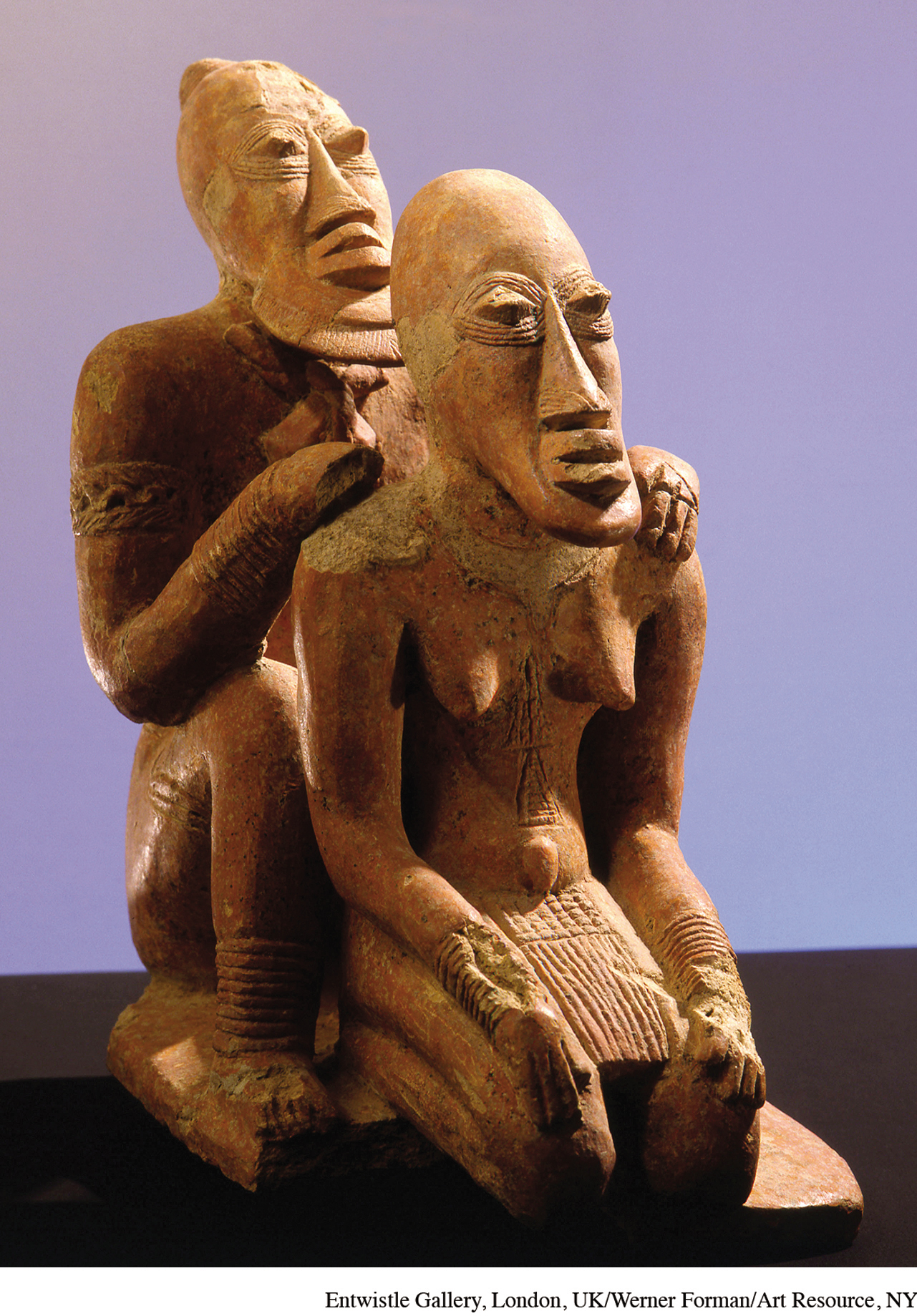Ways of the World with Sources
Printed Page 239
Ways of the World
Printed Page 205
Chapter Timeline
Along the Niger River: Cities without States
The middle stretches of the Niger River in West Africa witnessed the emergence of a remarkable urbanization (see Map 6.1). A prolonged dry period during the five centuries after 500 B.C.E. brought growing numbers of people from the southern Sahara into the fertile floodplain of the middle Niger in search of more reliable access to water. Accompanying them were their domesticated cattle, sheep, and goats; their agricultural skills; and their ironworking technology. Over many centuries (roughly 300 B.C.E.–900 C.E.), the peoples of this region created a distinctive city-based civilization. The most fully studied of the urban clusters that grew up along the middle Niger was the city of Jenne-jeno (jihn-AY jihn-OH), which at its high point probably housed more than 40,000 people.
How does the experience of the Niger Valley challenge conventional notions of “civilization”?

Terra-Cotta Statue from Jenne-jeno The artistic tradition of Niger Valley civilization includes a number of terra-cotta couples, reflecting perhaps the emphasis on the separate but complementary roles of men and women in much of African thought. This statue and others like it date to sometime after the twelfth century and may express the resistance of an indigenous tradition to the growing penetration of Islam. (Entwistle Gallery, London, UK/Werner Forman/Art Resource, NY)
Among the most distinctive features of the Niger Valley civilization was the apparent absence of a corresponding state structure. Unlike the cities of Egypt, China, the Roman Empire, or Axum, these middle Niger urban centers were not encompassed within some larger imperial system. Nor were they like the city-states of ancient Mesopotamia, in which each city had its own centralized political structure, embodied in a monarch and his accompanying bureaucracy. According to a leading historian of the region, they were “cities without citadels,” complex urban centers that apparently operated without the coercive authority of a state, for archeologists have found in their remains few signs of despotic power, widespread warfare, or deep social inequalities.5 In this respect, these urban centers resemble the early cities of Norte Chico or the Indus Valley civilization, where likewise little archeological evidence of centralized state structures has been found (see Chapter 2).
In place of such hierarchical organization, Jenne-jeno and other cities of the region emerged as clusters of economically specialized settlements surrounding a larger central town. The earliest and most prestigious of these specialized occupations was iron smithing. Working with fire and earth (ore) to produce this highly useful metal, the smiths of the Niger Valley were both feared and revered. Archeologist Roderick McIntosh, a leading figure in the excavation of Jenne-jeno, argued that “their knowledge of the transforming arts—earth to metal, insubstantial fire to the mass of iron—was the key to a secret, occult realm of immense power and immense danger.”6
Other specializations followed. Villages of cotton weavers, potters, leather workers, and griots (praise-singers who preserved and recited the oral traditions of their societies) grew up around the central towns. Gradually these urban artisan communities became occupational castes, whose members passed their jobs and skills to their children and could marry only within their own group. In the surrounding rural areas, as in all urban-based civilizations, farmers tilled the soil and raised their animals, but specialization also occurred in food production as various ethnic groups focused on fishing, rice cultivation, or some other agricultural pursuit. At least for a time, these middle Niger cities represented an African alternative to an oppressive state, which in many parts of the world accompanied an increasingly complex urban economy and society. A series of distinct and specialized economic groups shared authority and voluntarily used the services of one another, while maintaining their own identities through physical separation.
Accompanying this unique urbanization, and no doubt stimulating it, was a growing network of indigenous West African commerce. The middle Niger floodplain supported a rich agriculture and contained clay for pottery, but it lacked stone, iron ore, salt, and fuel. This scarcity of resources was the basis for a long-distance commerce that operated by boat along the Niger River and overland by donkey to the north and south. Iron ore from more than 50 miles away, copper from mines 200 miles distant, gold from even more distant sources, stones and salt from the Sahara—all of these items have been found in Jenne-jeno, exchanged no doubt for grain, fish, smoked meats, iron implements, and other staples. Jenne-jeno itself was an important transshipment point in this commerce, in which goods were transferred from boat to donkey or vice versa. By the 500s C.E., there is evidence of an even wider commerce, and at least indirect contact, from Mauritania in the west to present-day Mali and Burkina Faso in the east.
In the second millennium C.E., new historical patterns developed in West Africa (see Chapter 7). A number of large-scale states or empires emerged in the region—Ghana, Mali, and Songhay, among the most well-known. At least partially responsible for this development was the flourishing of a camel-borne trans-Saharan commerce, previously but a trickle across the great desert. As West Africa became more firmly connected to North Africa and the Mediterranean, Islam penetrated the region, marking a gradual but major cultural transformation. All of this awaited West Africa in later centuries, submerging, but not completely eliminating, the decentralized city life of the Niger Valley.
